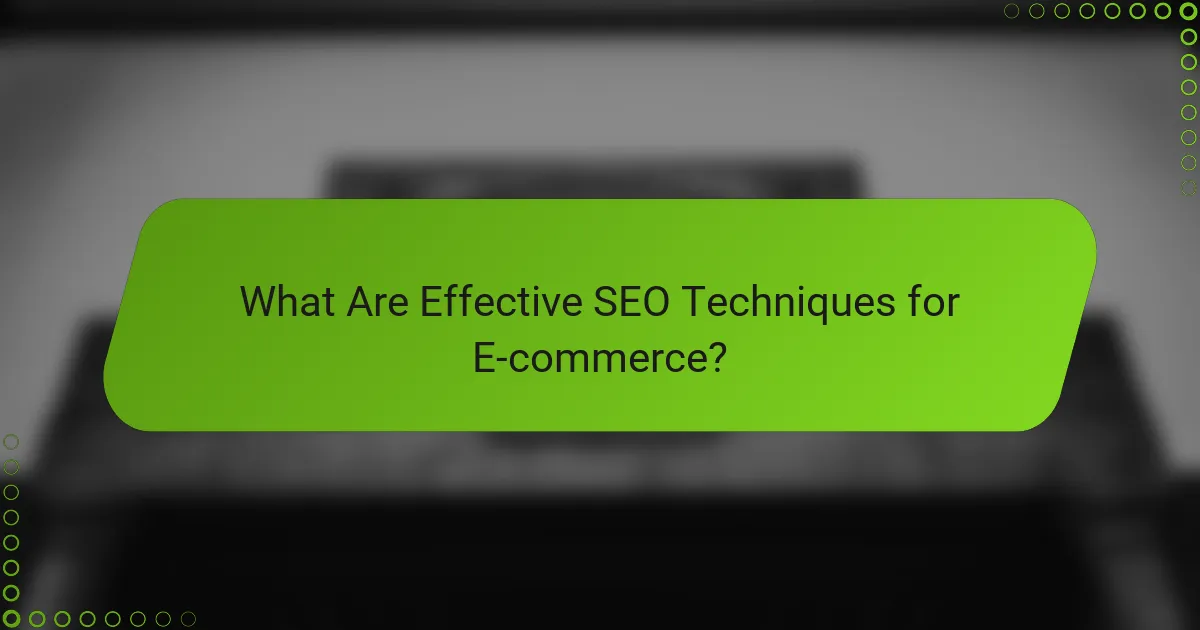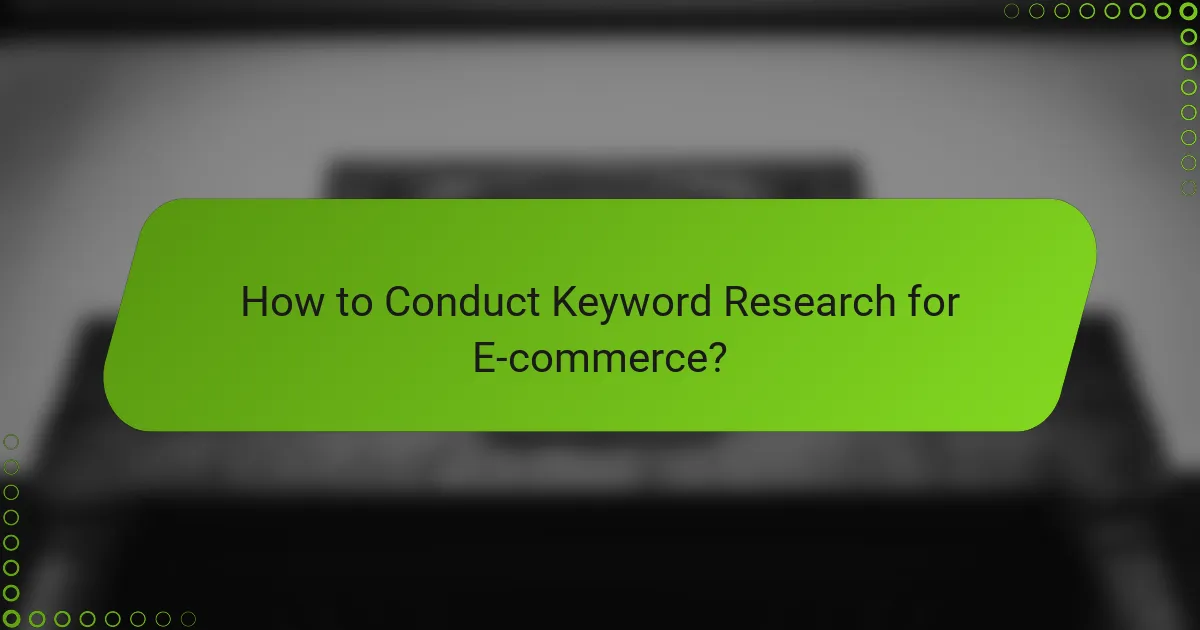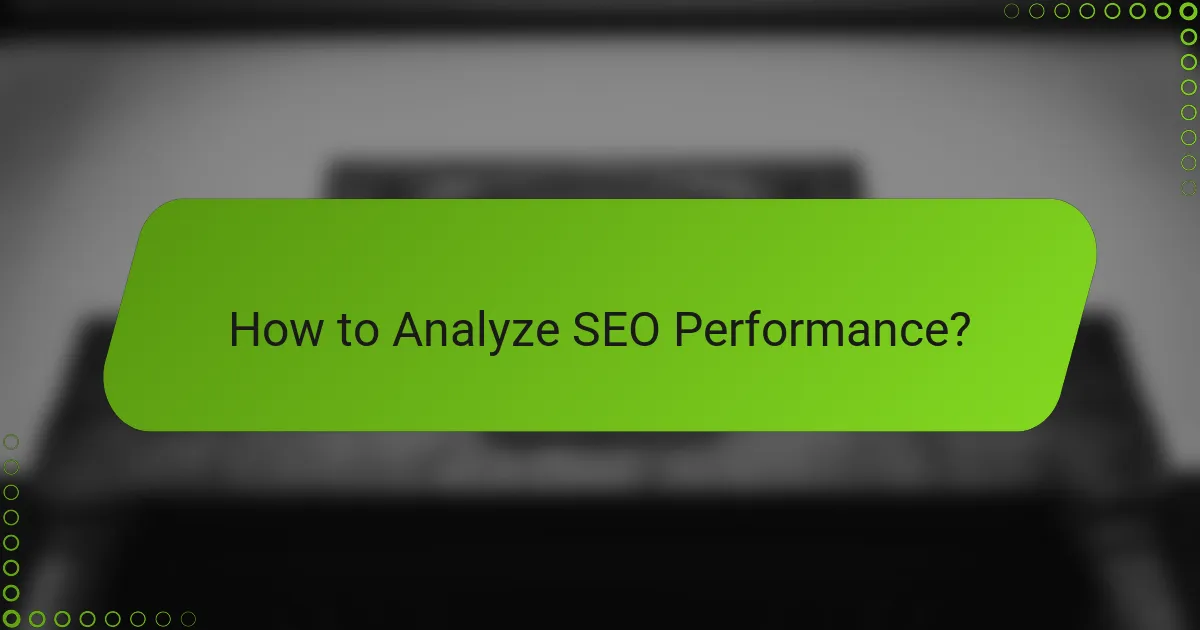In the competitive world of e-commerce, mastering SEO techniques is essential for improving visibility and attracting potential customers. By focusing on keyword research, on-page optimization, and analytics, online stores can enhance their search rankings and drive targeted traffic. Implementing these strategies not only boosts user experience but also increases sales and overall success in the digital marketplace.

What Are Effective SEO Techniques for E-commerce?
Effective SEO techniques for e-commerce focus on enhancing visibility and driving traffic to online stores. Key strategies include thorough keyword research, on-page optimization, link building, content marketing, and mobile optimization to improve search rankings and user experience.
Keyword Research Tools
Keyword research tools help identify the terms and phrases potential customers use when searching for products. Popular tools include Google Keyword Planner, Ahrefs, and SEMrush, which provide insights into search volume, competition, and related keywords.
When selecting keywords, focus on long-tail keywords that reflect specific product queries, as they often have lower competition and higher conversion rates. Aim for a mix of high-volume and niche keywords to capture a broader audience.
On-Page Optimization Strategies
On-page optimization involves refining individual web pages to improve their search engine rankings. Key strategies include optimizing title tags, meta descriptions, and header tags with targeted keywords, ensuring they accurately represent the content.
Additionally, use descriptive URLs and include alt text for images to enhance accessibility and SEO. Regularly updating content and ensuring fast loading times can significantly improve user engagement and search rankings.
Link Building Approaches
Link building is crucial for establishing authority and credibility in search engines. Effective approaches include guest blogging, collaborating with influencers, and creating shareable content that naturally attracts backlinks.
Focus on acquiring links from reputable sites within your industry to enhance your site’s trustworthiness. Avoid black-hat techniques like buying links, as they can lead to penalties from search engines.
Content Marketing Integration
Integrating content marketing with SEO enhances visibility and engagement. Create high-quality, informative content such as blog posts, product guides, and videos that address customer needs and incorporate relevant keywords.
Utilize various formats, including infographics and podcasts, to reach different audience segments. Promote your content through social media and email marketing to drive traffic and encourage sharing.
Mobile Optimization Practices
Mobile optimization is essential as a significant portion of e-commerce traffic comes from mobile devices. Ensure your website is responsive, meaning it adapts to different screen sizes and provides a seamless user experience.
Optimize loading speeds and simplify navigation on mobile devices. Implement AMP (Accelerated Mobile Pages) to enhance performance and improve search rankings, as Google prioritizes mobile-friendly sites in its results.

How to Conduct Keyword Research for E-commerce?
Conducting keyword research for e-commerce involves identifying relevant terms that potential customers use to search for products. This process helps optimize your online store’s visibility and drives targeted traffic, ultimately increasing sales.
Identifying Buyer Intent
Understanding buyer intent is crucial for effective keyword research. Buyer intent refers to the reason behind a user’s search query, which can be categorized into informational, navigational, and transactional intents. For e-commerce, focusing on transactional keywords, such as “buy shoes online” or “discount electronics,” is essential as they indicate a readiness to purchase.
To identify buyer intent, analyze the keywords your target audience uses and consider their stage in the buying process. Tools like Google Trends can help you gauge the popularity of specific terms over time, allowing you to align your keywords with user intent.
Using Google Keyword Planner
Google Keyword Planner is a powerful tool for discovering relevant keywords and estimating their search volume. To use it effectively, start by entering a few seed keywords related to your products. The tool will generate a list of related keywords along with metrics like average monthly searches and competition level.
When selecting keywords, aim for a mix of high-volume and long-tail keywords. Long-tail keywords, such as “organic cotton baby clothes,” often have lower competition and can attract more qualified traffic. Regularly revisit your keyword list to adapt to changing trends and consumer behavior.
Analyzing Competitor Keywords
Analyzing competitor keywords provides valuable insights into what works in your niche. Use tools like SEMrush or Ahrefs to identify the keywords your competitors rank for and their estimated traffic. This information can help you uncover gaps in your own keyword strategy.
Focus on keywords that have a good balance of search volume and competition. If competitors are successfully ranking for specific terms, consider how you can differentiate your content or offerings. Additionally, look for keywords they might be missing, which could present opportunities for your e-commerce site.

What Are the Best On-Page SEO Techniques?
The best on-page SEO techniques focus on optimizing individual web pages to rank higher and earn more relevant traffic. Key strategies include refining title tags, crafting compelling meta descriptions, utilizing header tags effectively, and optimizing images for better performance.
Title Tag Optimization
Title tag optimization is crucial for SEO as it directly influences search engine rankings and click-through rates. A well-crafted title tag should be concise, ideally between 50-60 characters, and include primary keywords relevant to the page content.
To enhance effectiveness, place the most important keywords at the beginning of the title. Avoid keyword stuffing; instead, aim for a natural flow that accurately describes the page. For example, a title like “Affordable SEO Services for Small Businesses” is clear and keyword-rich.
Meta Description Best Practices
Meta descriptions serve as a summary of your page content and can significantly impact user engagement. Aim for a length of about 150-160 characters, incorporating primary keywords and a compelling call to action to entice clicks.
Ensure that each meta description is unique to avoid duplication across pages. For instance, a meta description like “Discover our expert SEO services tailored for small businesses. Boost your online presence today!” effectively summarizes the content while encouraging user action.
Header Tag Usage
Header tags (H1, H2, H3, etc.) structure your content and improve readability, which is essential for both users and search engines. The H1 tag should contain the main keyword and clearly represent the page’s topic, while H2 and H3 tags can be used for subheadings to organize content logically.
Use header tags to break up long sections of text, making it easier for readers to scan the content. For example, using H2 for major sections and H3 for subsections can enhance clarity and SEO performance.
Image Optimization Techniques
Image optimization is vital for improving page load speed and overall user experience. Ensure images are in appropriate formats (like JPEG or PNG) and compressed to reduce file size without sacrificing quality. Aim for images that are under 100 KB when possible.
Additionally, use descriptive file names and alt text that includes relevant keywords. This not only helps with SEO but also improves accessibility. For example, instead of naming an image “IMG1234.jpg,” use “seo-services-small-business.jpg” to provide context.

How to Analyze SEO Performance?
Analyzing SEO performance involves assessing various metrics to understand how well your website is ranking and attracting traffic. Key areas to focus on include user behavior, keyword effectiveness, and overall site engagement.
Using Google Analytics
Google Analytics is a powerful tool for tracking website performance and user interactions. By setting up goals and conversions, you can measure how well your site meets its objectives, such as lead generation or sales.
To get started, ensure that your Google Analytics account is properly linked to your website. Monitor metrics like sessions, users, and page views to gauge overall traffic trends. Additionally, use the Acquisition reports to identify which channels are driving the most traffic.
Tracking Keyword Rankings
Tracking keyword rankings helps you understand how your website performs for specific search terms. Regularly monitor your rankings using tools like SEMrush or Ahrefs to see where you stand against competitors.
Focus on a mix of short-tail and long-tail keywords to capture a broader audience. Aim for a ranking within the top 10 for primary keywords, as this is where most clicks occur. Adjust your content strategy based on ranking changes to improve visibility.
Monitoring Bounce Rates
Bounce rate indicates the percentage of visitors who leave your site after viewing only one page. A high bounce rate may suggest that your content is not engaging or relevant to users.
To improve bounce rates, analyze the pages with the highest rates and consider optimizing their content, layout, or loading speed. Aim for a bounce rate below 40% for optimal engagement, but recognize that this can vary by industry.

What Are the Key Metrics for SEO Success?
The key metrics for SEO success include organic traffic growth, conversion rate optimization, and return on investment (ROI). These metrics help evaluate the effectiveness of SEO strategies and guide improvements to enhance online visibility and profitability.
Organic Traffic Growth
Organic traffic growth measures the increase in visitors arriving at your website through unpaid search results. A steady rise in organic traffic indicates that your SEO efforts are effectively improving your site’s visibility on search engines.
To enhance organic traffic, focus on keyword research, quality content creation, and on-page optimization. Regularly track traffic trends using tools like Google Analytics to identify successful strategies and areas needing improvement.
Conversion Rate Optimization
Conversion rate optimization (CRO) assesses how well your website turns visitors into customers or leads. A higher conversion rate signifies that your site effectively meets user needs and encourages desired actions.
To boost conversion rates, ensure your website is user-friendly, with clear calls to action and optimized landing pages. A/B testing different elements can help identify what resonates best with your audience, leading to improved performance.
Return on Investment (ROI)
Return on investment (ROI) in SEO measures the profitability of your SEO initiatives compared to the costs incurred. A positive ROI indicates that your SEO strategies are generating more revenue than they cost to implement.
To calculate ROI, use the formula: (Revenue from SEO – Cost of SEO) / Cost of SEO. Regularly monitor this metric to assess the financial effectiveness of your SEO campaigns and adjust your strategies accordingly for better results.
